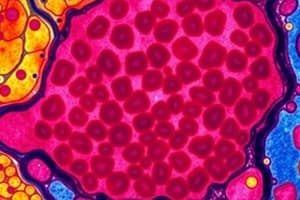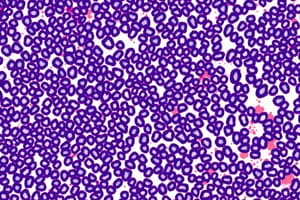Podcast
Questions and Answers
What is the main function of smooth muscles in the body?
What is the main function of smooth muscles in the body?
- Power the heart
- Perform involuntary contractions for digestion and circulation (correct)
- Contribute to sensory perception
- Allow voluntary movement
Which type of muscle tissue is responsible for constantly contracting to power the heart?
Which type of muscle tissue is responsible for constantly contracting to power the heart?
- Cardiac muscles (correct)
- Smooth muscles
- Nervous tissue
- Skeletal muscles
What is the primary role of neurons in nervous tissue?
What is the primary role of neurons in nervous tissue?
- Allow voluntary movement
- Power the heart
- Transmit information rapidly via electrical and chemical signals (correct)
- Perform involuntary contractions
Which of the following is NOT a function of neural pathways formed by neurons?
Which of the following is NOT a function of neural pathways formed by neurons?
How do neurons communicate with other nerve cells, muscles, or glands?
How do neurons communicate with other nerve cells, muscles, or glands?
Which tissue type forms thin sheets acting as barriers against foreign invaders and facilitating exchanges between cells and their environment?
Which tissue type forms thin sheets acting as barriers against foreign invaders and facilitating exchanges between cells and their environment?
What primary function do connective tissues serve in the body?
What primary function do connective tissues serve in the body?
Which type of muscle tissue enables movement and generates force through contraction?
Which type of muscle tissue enables movement and generates force through contraction?
Which tissue type provides flexibility and cushioning for joints in the body?
Which tissue type provides flexibility and cushioning for joints in the body?
What is the primary function of muscle tissue?
What is the primary function of muscle tissue?
Flashcards are hidden until you start studying
Study Notes
Tissue Types: Understanding Life's Building Blocks
Life is built from complex structures. At its most fundamental level, these structures can be traced back to tissues, specialized groups of cells working together with specific functions. In this exploration, we will delve into four primary tissue types, each playing vital roles within our bodies.
Epithelial Tissue
Epithelial tissue forms thin sheets covering surfaces both inside and outside the body. These sheets act as barriers against foreign invaders while also facilitating exchanges between cells and their environment. Examples of epithelial tissue abound throughout our bodies—from the skin's outermost layer to the lining of blood vessels and organs like lungs, kidneys, and stomach.
Connective Tissue
Connective tissues bind and support various parts of the body, providing structure, stability, and strength. This vast category encompasses several different types; some examples are loose connective tissue, dense regular connective tissue, cartilage, bone, and adipose tissue. Cartilage provides flexibility and cushioning for joints, bones impart rigidity and protection, whereas fatty tissue stores energy reserves. Each type plays essential roles in maintaining proper physiological functioning.
Muscle Tissue
Muscles enable movement, generating force through contraction. There are three types of muscle tissue: smooth, skeletal, and cardiac. Smooth muscles line internal organs, such as the intestines and blood vessels, performing involuntary contractions necessary for digestion and circulation. Skeletal muscles attached to bones allow us to move voluntarily. Cardiac muscles specifically power the heart, constantly contracting without conscious control.
Nervous Tissue
Nervous system tissues consist primarily of neurons--specialized cells capable of transmitting information rapidly over great distances via electrical and chemical signals. Neurons communicate with other nerve cells, muscles, or glands by sending messages along axons and dendrites. Together they form neural pathways responsible for sensory perception, integration, decision making, motor responses, learning, memory, and consciousness.
Each tissue type has unique characteristics and serves diverse purposes across our bodies. By understanding them better, one gains insight into how elaborate our biology truly is—each cell type contributing to maintain life's intricate balance.
Studying That Suits You
Use AI to generate personalized quizzes and flashcards to suit your learning preferences.




